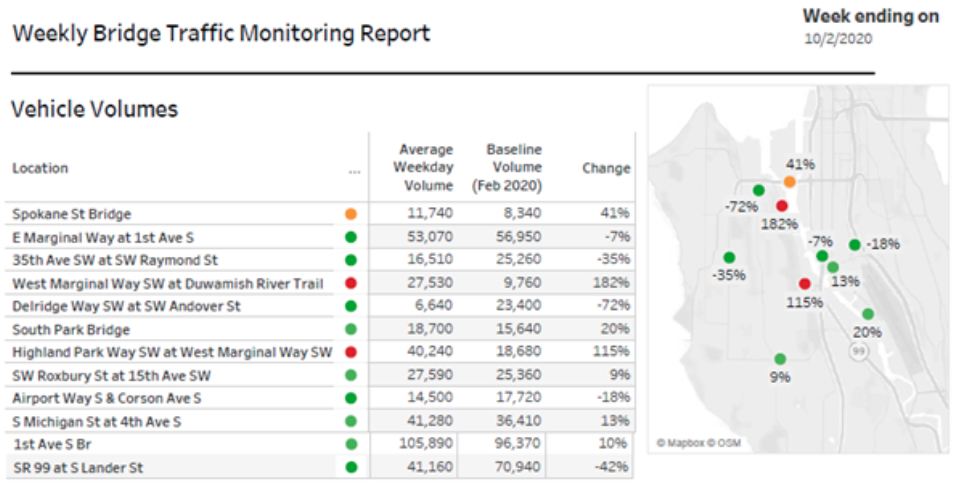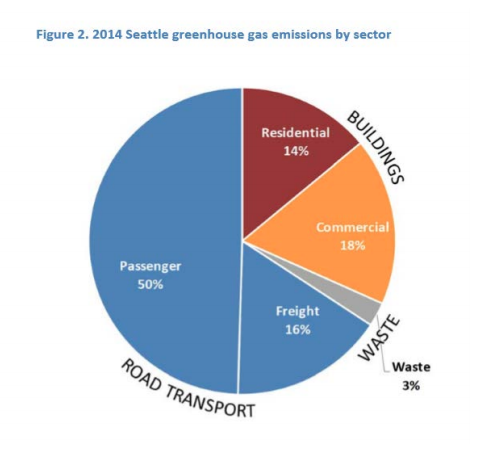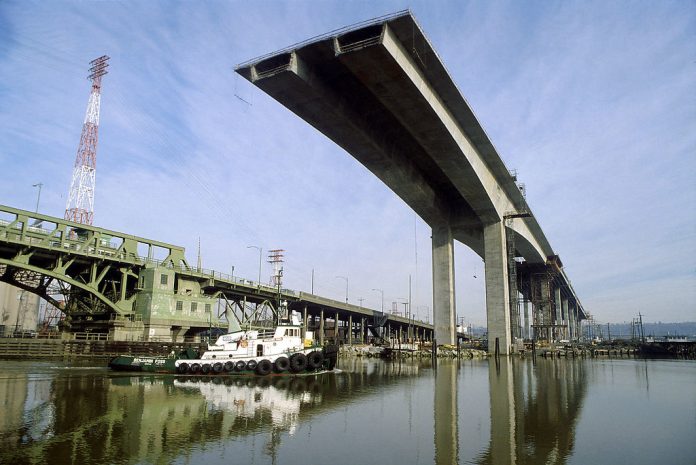Today the West Seattle Community Bridge Taskforce will meet, inching the city further toward a decision that will impact everyone who uses transportation in Seattle, particularly in the southwest quadrant. Will the West Seattle high-rise bridge be repaired or replaced with a new bridge? Last week, SDOT released a cost-benefit analysis that analyzed six alternatives; Shaun Kuo broke those down here on Friday.
A few of the options studied, like shoring the structure or replacing with a tunnel, were all but ruled out by the data in the report. Still the final decision isn’t clear. The study, which will be the primary public-facing document backing Mayor Jenny Durkan’s decision, only provides a basic surface level examination of the impact of each choice on the City’s climate commitments and goals, and it doesn’t show its work.
The Durkan administration has always underplayed the impact that transportation projects have on emissions, so this is not a huge surprise, but for a project that could end up having an impact of a billion dollars or more on the city’s transportation budget in the long-term, we must demand a more rigorous analysis of the climate impacts of any path forward.
The cost-benefit analysis only looked at the emissions impacts for each option in terms of the direct impact coming from vehicles detouring around the closed bridge. Particularly notable was the fact that not adding back the vehicle capacity was not even considered as a baseline. From the study: “We measured air quality by evaluating the additional tons of greenhouse gas (GHG) emissions emitted because of increased vehicle miles traveled (VMT) from detour routes while the bridge is closed, as compared to the VMT if the bridge were open to traffic.”
Therefore, the study states that the option that would repair the bridge for use by 2022 would produce 128,000 more tons of carbon compared to 161,000 more tons of carbon produced waiting for a full replacement in 2026. The biggest factor in each number turns out to merely be the number of years that a full-capacity bridge is out of commission. The repair option includes the time that a replacement bridge would be constructed several decades from now, with light rail to West Seattle up and running, producing slightly fewer emissions per year, but according to these numbers the additional emissions translate to between 1% and 2% of Seattle’s total road transportation emissions for all options.
And yet a closed West Seattle Freeway is a demand management tool, whether we think the outcome is acceptable or not. Obviously the Covid crisis is still impacting travel patterns, particularly during peak hours. But the Washington State Department of Transportation (WSDOT) data shows volumes on I-5 through Seattle are only down around 10 to 15% compared to 2019 levels. Contrast that with data that SDOT has been releasing on screenline locations around West Seattle: the 84,000 vehicle trips that were using the high bridge translates to around 18,000 more vehicles on Marginal Way, 3,000 more vehicles using the South Park bridge, around 10,000 more vehicles on the 1st Ave S bridge, and 3,500 more vehicles on the Spokane Street low bridge, soon to get automatic camera enforcement. Thus, 84,000 daily vehicle trips became 34,500. While there may be additional locations seeing more traffic than in February that aren’t showing up here, the bridge closure is clearly having an impact on overall traffic volumes.

This is not to minimize the impact that the bridge closure is having on people’s lives. Access to heath care in particular has gotten considerably tougher for West Seattle residents, among other essential needs. Asking for a climate impact study does not diminish the other considerations laid out in the cost-benefit analysis. But this information is particularly relevant considering the likelihood of impacts the bridge decision will have on other areas of Seattle’s transportation budget: money that also is used to make investments in decarbonizing Seattle’s transportation system, which accounts for two-thirds of Seattle’s greenhouse gas emissions.

The neighborhoods that are experiencing the brunt of detours from the West Seattle Bridge are unfortunately the same neighborhoods that have experienced decades of disinvestment in the first place. Transportation infrastructure like Boeing Field, SR 99 and SR 509, and the Superfund site that is the Duwamish River have had cumulative impacts on the neighborhoods of South Park and Georgetown, leading to an average life expectancy that is 13 years shorter than that of residents of secluded neighborhoods in North Seattle. The highway traffic levels that SDOT is seeking to maintain bake in that pollution, and trying to curb pollution by giving cars faster and more direct routes only works so long before congestion returns–and it induces more people to drive in the process.
The cost-benefit analysis pays special attention to the diversion of traffic through these neighborhoods: it states that 59% of the current diversion routes from the bridge are through communities with “high representation of people of color (23 to 89 percent).” The analysis says that with a repair option there would be 58.8 million more vehicle trips through such areas compared to 62.5 million more with a replace option. This translates to around 12 million additional trips per year taken at face value, out of approximately 700 million total trips per year taken in passenger vehicles in Seattle. Again, we cannot fully see in this report how many of those trips are actually likely to be discouraged with the high bridge staying closed, or with more robust diversion programs in all of those areas. The report itself recommends “further study on impacts to marginalized communities’ economies from more than a perspective focused on detour routes through the identified neighborhoods.”
Much more study appears to be needed, considering the fact that the city that has committed to reducing emissions from passenger vehicles by 82% from where they were in 2008 in the next decade, and has made very little progress toward that goal. A mayor truly leading on climate change would ensure that the highest level of analysis was conducted here, but with Mayor Durkan we will have to push to ensure that it is done.
Ryan Packer has been writing for The Urbanist since 2015, and currently reports full-time as Contributing Editor. Their beats are transportation, land use, public space, traffic safety, and obscure community meetings. Packer has also reported for other regional outlets including BikePortland, Seattle Met, and PubliCola. They live in the Capitol Hill neighborhood of Seattle.


